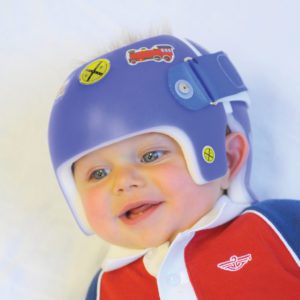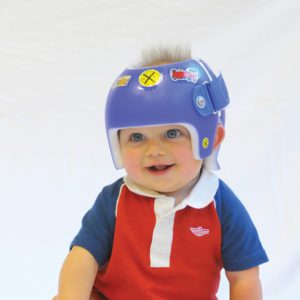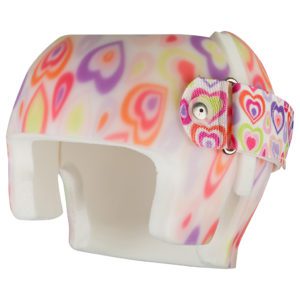Frequently Asked Questions
Here are some frequently asked questions Ortho Design receives:
Do all infants diagnosed with Deformational Plagiocephaly need a helmet?
Not all infants diagnosed with Deformational Plagiocephaly require a helmet. The treatment approach for Deformational Plagiocephaly varies depending on the severity and specific characteristics of the condition. Helmets, also known as Cranial Remolding Orthoses (CRO), are one of the treatment options available for more moderate to severe cases. Ortho Design only recommends helmets when a level 3 severity is reached on the CHOA Scale for Plagiocephaly (Children’s Healthcare Of Atlanta).
In less severe cases, repositioning techniques and physical therapy exercises may be recommended to encourage symmetrical head growth and alleviate the flattening. These techniques involve changing the infant’s head position during sleep, tummy time, and daily activities. This approach aims to reduce the pressure on specific areas of the head and promote natural reshaping.
How long does the process take?
On average, treatment programs with cranial remolding orthosis take approximately 12 to 16 weeks for infants between the ages of five and seven months. Older infants or those with sever plagiocephaly may require a longer treatment program because head growth slows after 12 months.
Research indicates that the greatest symmetry can be attained through early intervention, although some correction may be possible in infants over 18 months. The helmets are worn about 23 hours a day to achieve the best possible results. They should be removed at bath time so that your infant’s head, and the helmet, can be cleaned.
Important: The orthosis should not be removed when your infant is sleeping, as this will allow the head to rest on the area that is being treated.
How early should treatment start?
In British Columbia, Pharmacare does not approve CROs before the age of five months. This timing corresponds with allowing the infants time to roll, change position, and hopefully correct themselves or with repositioning and physiotherapy.
How do I know it is going to work?
Corrective orthoses typically yield outstanding outcomes and do not have any documented side effects related to head growth. Moreover, infants generally find these helmets comfortable and tolerate wearing them quite well.
Will Ortho Design assist me throughout the whole process?
Every aspect of the cranial remolding process is overseen by our Certified Orthotists, as mandated in British Columbia. From the initial measurements to the subsequent follow-up visits, we are dedicated to supporting you throughout the entire journey, providing the highest level of care and assistance.
What types of adjustments should we anticipate during our infant's treatment program?
Cranial remolding orthoses are specifically designed to apply pressure on elevated areas of the head while creating gaps in the areas that are relatively lower. This approach facilitates direct growth of the head. As the treatment program progresses, certain adjustments can be expected. These adjustments may involve the removal of liners to encourage more growth in targeted regions. Additionally, pads may be added in specific areas to promote symmetrical or proportional growth of the infant’s head. Furthermore, the plastic material used in the orthosis can be heated and reshaped to accommodate changes in the shape of the head.
Please Note: After each adjustment, it will be important to closely monitor your infant’s head to ensure it adapts well to the adjustments.
How should the remolding helmet fit on my infant's head?
In the initial two weeks of treatment, it is common for the cranial orthosis to shift on your infant’s head, particularly if their head shape is asymmetrical. The caregiver may need to reposition the band to ensure proper alignment frequently. However, if the band rotation obstructs vision, causes discomfort around the ears, or if the infant experiences any skin issues, an adjustment to the orthosis may be necessary before the scheduled appointment.
After two weeks of wearing the orthosis for approximately 23 hours a day, any rotation should be minimal. It is important to remember that you can always reach out to Ortho Design if you have any questions or concerns at any point during the treatment process. We are available to provide guidance and address any issues that may arise.
How do I clean my infants remolding helmet?
The cranial orthosis can be cleaned with rubbing alcohol, baby shampoo, or germicidal soap. Wet a soft, non-abrasive cloth and vigorously wipe out the entire inside of the orthosis at least once a day. This will help to prevent bacteria from building up on the inner liner.
The infant’s head should also be washed daily with a mild soap or baby shampoo to soothe scalp irritation that can occur from a build-up of heat and perspiration inside the orthosis.
Warning: Use only 70% alcohol to avoid any harmful irritation to your infant’s skin and be sure that the orthosis is completely dry before putting it back on your infant’s head.
Is the cost of cranial orthosis covered by MSP?
No, MSP does not cover the cost although it is often covered or partially covered by private insurance plans. Please get in touch with us for information about financial options and the Ministry of Children Services funding.



